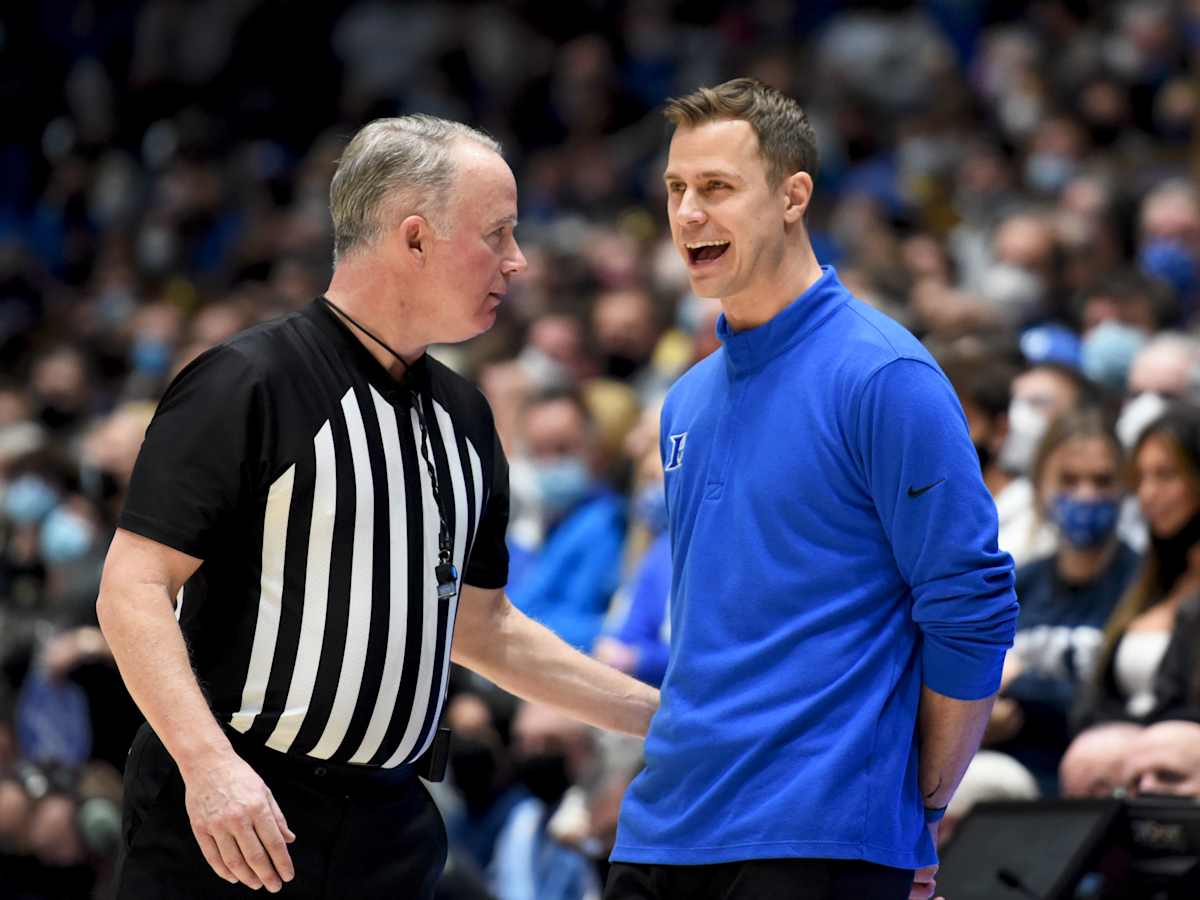In an era where roster turnover is the norm, Duke’s decision to not have a single scholarship player enter the transfer portal this offseason is jaw-dropping. According to College Sports Network, “we’re the only program in the country that has not had a player enter the transfer portal or come in from the transfer portal”
BallDurham echoed this sentiment, noting Duke was one of just three Division I teams—alongside Tennessee and Boston University—to retain their full roster (Ball Durham).
Scheyer has secured key returning players like Caleb Foster, Isaiah Evans, Patrick Ngongba, and Maliq Brown. These guys had the freedom to leave—or even test the NBA waters—but chose to stay, reinforcing their belief in the program’s direction (Ball Durham).
1.3 Contrast with Last Offseason
This stands in stark contrast to the previous offseason, when Duke lost seven players to the portal and two to the NBA. That roster upheaval forced Scheyer to rebuild practically from scratch (Front Office Sports). That earlier rebuild, ironically, helped set the template for the renewed stability this offseason.
2. Culture of Trust, Transparency, and Accountability
2.1 Honest Conversations & No Promises
Scheyer’s player-first approach emphasizes open dialogue and realistic expectations. He’s upfront: “no promises of starting roles or guaranteed minutes, only the belief in each player’s potential and the opportunity to earn their place” (College Sports Network).
This honesty builds trust—especially when players see that merit, not seniority or promises, drives roles.
2.2 Collective “No” to the Portal
He encapsulated the mindset: “we’ve all said no to have something special” (College Sports Network). That statement embodies a unifying commitment: remaining together for the larger vision rather than seeking quick fixes.
2.3 Shared Experience Builds Unity
Speaking to On3, Scheyer highlighted that this summer would be different—not focused on isolated individual work, but team-driven challenges to foster bonds and a playoff mentality (On3). He said:
This shared adversity mirrors life on the court during close-knit games and helps convert a group of talented individuals into a living organism.
3. Strategic Roster Construction: Youth, Experience, Continuity
3.1 Youth-Based Blueprint
Duke has bucked the trend of aging rosters reliant on portal veterans. Instead, they leaned into an old-school youth model, filled with freshmen-led energy. Their starting lineup last year had the lowest average age in the Sweet Sixteen—19.4 years old—compared to 21.6 for Houston and Florida, and 23.2 for Auburn (On3, Front Office Sports).
This youthful formula is revolutionary. In the modern era, most contenders are flooded with grizzled transfers and seniors.
3.2 Quality Over Quantity in Portal Moves
Scheyer didn’t entirely ignore the portal, but he was selective: adding only three experienced voices—Mason Gillis (Purdue), Maliq Brown (Syracuse), and Sion James (Tulane)—targeted to address specific gaps. He avoided chasing rankings and instead chose players with character, fitting profile needs (The Chronicle).
3.3 Power Pack of Fresh Talent
The incoming freshman class is electric:
- Cooper Flagg: consensus No. 1 high school prospect—Wooden Award winner, Player of the Year, future NBA lottery pick (Duke Basketball Report).
- Cameron Boozer: Son of NBA veteran Carlos Boozer, projected top-3 pick in 2026 (College Sports Network).
- Cayden Boozer, Nik Khamenia, Shelton Henderson, and Sebastian Wilkins round out an elite class with depth, versatility, and U.S.-international pedigree (College Sports Network).
Simultaneously, the veterans returning—Evans, Foster, Ngongba—provide a stabilizing core. Scheyer’s formula blends raw upside with proven assets (Duke Basketball Report).
3.4 Intentional Team Composition
Scheyer abandoned blanket national rankings in favor of purposeful, balanced recruiting:
“It was about putting together the best team, not to win your transfer portal rankings … best team.” (College Sports Network).
This signifies evolution for Duke: true roster engineering tailored to current ACC and national landscapes.
4. Coaching Continuity & Succession
4.1 Scheyer as Coach-K’s Successor
Scheyer’s seamless transition from Mike Krzyzewski’s legend to building his own program is rare in college sports. In just three seasons, he’s upheld Duke’s national prominence, achieving an 88–21 record and Final Four appearance (College Sports Network, Wikipedia).
This success is built on continuity—Scheyer is the first Duke coach without a Krzyzewski-era rotational player, ushering in a fully Scheyer-constructed roster .
4.2 Staff Consistency
Stability extends beyond players. Scheyer emphasized how coaching staff cohesion reinforces culture and continuity .
4.3 Recognized Coaching Quality
Fans and analysts on platforms like Reddit back this up:
“Scheyer’s strides as a coach this year has been amazing… three seasons in and he’s got an ACC title, two ACC tourney titles, a 30+ win season…” (Reddit, Reddit)
“Why isn’t Jon Scheyer getting serious consideration for Coach of the Year? He’s assembled a terrifically balanced team…” (Reddit)
These recognitions affirm he’s not only upholding Duke traditions but enhancing them.
5. The Competitive Landscape: Context Matters
5.1 Volatility Across College Basketball
The new “free-agent” era, courtesy of NIL and relaxed transfer rules, has led to roster instability. The Washington Post noted “coaches must rebuild annually” and cited Duke’s departure from typical trends (The Washington Post).
5.2 Duke vs. The Pack
Compared to programs like Auburn, Florida, Houston, etc.—who rely heavily on transfers—Duke’s path is more calculated. They let NIL supplement, not dominate.
5.3 The Risk-Reward Equation
While youth offers elite upside, it’s notoriously unpredictable. Developing these freshmen, especially under pressure, is critical. But Scheyer demonstrated a similar risk gamble last year—roster rebuild—that paid dividends with an ACC crown and a Final Four run .
6. What It Says About Scheyer’s Leadership
6.1 Trusting the Process
Trust shines two ways: Scheyer trusts his players’ commitment to stay; players trust Scheyer’s vision over instant gratification.
6.2 Player Development Strategy
He’s not afraid to invest in and develop returning players (like Evans, Foster, Ngongba), even when they’re not superstars. That ability to maximize upside signals a data-driven, developmental mindset .
6.3 Embracing Culture Over Chaos
By avoiding the transfer jostle, Scheyer preserves cultural cohesion—a powerful intangible often overlooked amid star power and NIL hustles.
7. Challenges & Future Roadmap
7.1 Performance Expectations
Expectations are sky-high. Flagg’s departure to the NBA, along with other stars, leaves gaps to fill. The fresh class must quickly deliver—for both team success and their own draft aspirations.
7.2 Managing Freshmen Integration
Translating high school dominance into college success is never easy. Depth must be maintained amid new roles, rotations, and chemistry challenges.
7.3 Portal Flexibility
While the portal won’t define their strategy, Scheyer’s door remains open for right-fit additions, especially later in the offseason. That allows him flexibility without compromising identity (The Chronicle).
8. The Grand Vision
8.1 A Blueprint for College Basketball
Scheyer’s path could be a case study:
- Maintain roster continuity through development.
- Infuse specific talent, youth and experience.
- Use portal and NIL tactically rather than tactically.
That could push the narrative: stability + youth + vision > churn + quick fixes.
8.2 Sustaining Elite Standards
At Duke, the standard isn’t just winning—it’s how you win. Scheyer is reinforcing that legacy—not just sustaining it, but evolving it in his own image.
8.3 Adapting to the New Market
Rather than becoming a prisoner of NIL and portal trends, Scheyer memos “Yes, we’ll play that game—but only on our terms.”
Jon Scheyer and Duke’s offseason is a quiet revolution. In a sport increasingly defined by shuffling rosters and next-day player movement, Duke has chosen stability. In an era where promotional NIL appeals dominate, Scheyer chose culture and accountability. In a market driven by mass recruitment, Duke became surgical—prioritizing fitting pieces over star power.
Their message? Trust in the system, cultivate it, and let it flourish organically. If it works, it won’t just put Duke back in contention—it could reshape how elite programs think about team-building in the modern era.Let me know if you’d like to explore specific comparisons, game analytics, or recruitment trends for deeper insights!



